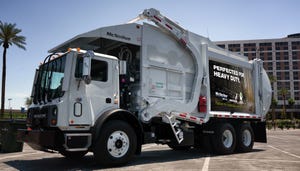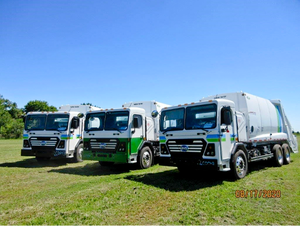Nostros Reciclamos: We Recycle
February 1, 1997
Bob Coyle
On the surface, Santa Ana, Calif., resembles any other city developing a new curbside recycling program. But, upon closer inspection, those similarities quickly disappear.
Santa Ana, situated in Orange County, had to find a way to expand its waste services in a politically and financially viable manner - an especially critical aspect given the county's recent and well-publicized bankruptcy. To complicate matters, the city also had to meet California's 50 percent waste diversion requirement by 2000.
Aware of the county's fiscal and political climate, Waste Management of Orange County, Santa Ana, which serves the area through its Great Western Reclamation division, developed an innovative agreement with the city which would help expand its services to meet the waste reduction requirement and also create cost efficiencies for both parties.
The key elements of the agreement included a 10-year extension of the city's contract with Waste Manage-ment and a city financing mechanism - made possible with the assistance of the California Environmental Finance Corporation - to acquire a fleet of new, automated vehicles and carts for the recycling program.
In turn, Waste Management promis-ed to implement a comprehensive recycling program that would provide long-term stable rates for customers and a $1.75 per month discount for eligible senior citizens. The company also guaranteed the city nearly $1.4 million in annual savings for the contract's duration.
Though the existing contract's extension sparked some controversy among city council members, customer reaction to the new program was positive, which indicated that the residents would accept major changes in their waste management system as long as they perceived that the service providers were looking out for their short- and long-term interests.
Language Barriers With the financial plan in place for the city-wide recycling program, Waste Management's next challenge was to fine tune the program's operational details and to develop a communications program that would generate widespread acceptance and participation. This common procedure turned complex because more than two-thirds of Santa Ana's 310,000 residents are Hispanic. The language barrier loomed large: 47 percent of the Hispanic population listed Spanish as their primary household language.
To ensure a smooth transition into the program, the city needed customer input on the planned operations. However, given Santa Ana's multi-lingual population, the city first had to develop an effective communications program that would reach its non-English speaking citizens.
In an effort to make the recycling program easy to understand and use, residents were surveyed to determine their opinions and understanding of recycling. Focus groups were gathered including both Spanish- and English-language dominant Hispanics as well as English-speaking, non-Hispanics.
The results revealed some interesting perceptions of recycling behavior and attitudes. For example, although separating recyclables is not currently part of the trash collection process in Santa Ana, the vast majority of residents reported that they already sorted items such as bottles, cans and newspapers.
Additionally, most were in favor of a curbside re-cycling program, citing the program's positive effect on Santa Ana's image and the belief that they would be creating a better en-vironment for their children.
The findings of the research were used as a foundation for making final decisions on the program's roll-out. For example, it found that customers preferred the 96-gallon carts over the 35- and 64-gallon carts for trash, recyclables and green waste.
Respondents who were hesitant about the size because they were told that items outside the cart would no longer be picked up were satisfied to learn that carts could be exchanged for other sizes after the program roll-out, and that additional carts would be available for a small monthly fee.
These results to questions about pick-up schedules, separation categories, compliance requirements and education methods served as a guide in making final decisions on these issues and also led to the selection of the program's slogan.
Using Ethnic Media Concentrating on issues uncovered in the focus group research, Waste Management conducted presentations at churches, schools and recreation facilities to introduce the new recycling program to community groups. All presentations - attended by bilingual staff members - were designed to address both Hispanic and non-Hispanic residents' concerns.
Isolating non-English speakers is often difficult and expensive. How-ever, making bilingual staff and information available is crucial to the success of programs in cities that have a high percentage of residents who are not proficient at English.
In addition to providing bilingual information to residents, it is important to develop relationships with local ethnic media to reach non-English speakers in a targeted and persuasive manner. Here, the media relays information of interest to their audience, and the organization supplying the information delivers its message through a credible and trusted source.
Media relations is also cost-effective and allows you to disseminate information to communities that may be too small to reach through other ways. For example, Santa Ana's small Vietnamese community can be reached through its Vietnamese-language print and radio outlets.
Effective Outreach Another vital component to any communications program is community outreach. After all, your recycling program employees are experts on the subject and, if well trained, can both introduce the program to the community and enhance the company's image.
Speaking to community groups prior to the program's implementation helps acceptance and can uncover additional reactions. Community presentations also are more persuasive - both before and after implementation - particularly with specific issues.
To help increase the proper separation of recyclables, and to reduce contamination, it is important to have company representatives present these details as often as possible. This is especially important among non-English speaking communities because much emphasis and understanding can be lost through translations of posters, stickers and reference materials.
Recycled Market Boosters Since the market for recycled materials is hardly steady or profitable, waste service providers need to take more responsibility for educating the public.
In Waste Management's case, much of the money that was once paid for county landfill services now is being used to send the recycled materials to vendors, since only about 25 percent of the recycled materials are profitable. And while a large company like Waste Management is able to find buyers for its recycled materials, it would be able to offer lower rates to customers and generate greater profit if there was a stronger recycled product market.
Though the dynamics of the recycled products market is complex, companies like Waste Management of Orange County are using the launch of its curbside recycling program to create an ongoing dialogue with community groups, school-aged children and the media on recycling issues. After all, the public and waste service providers both would benefit if consumers recycled waste and purchased products made from recycled materials.
Trucks: 23 Volvo WX42T tractors with 5th wheel; 23 Heil 33-yard trailers; fully automated grabber
Services provided: recycling, residential collection, greenwaste
Employees: 23 "commercial class A" rated drivers
Types of containers used: Cascade carts; Heil lifter
Customers: 40,000 residential
Service area: City of Santa Ana,Calif.
You May Also Like


